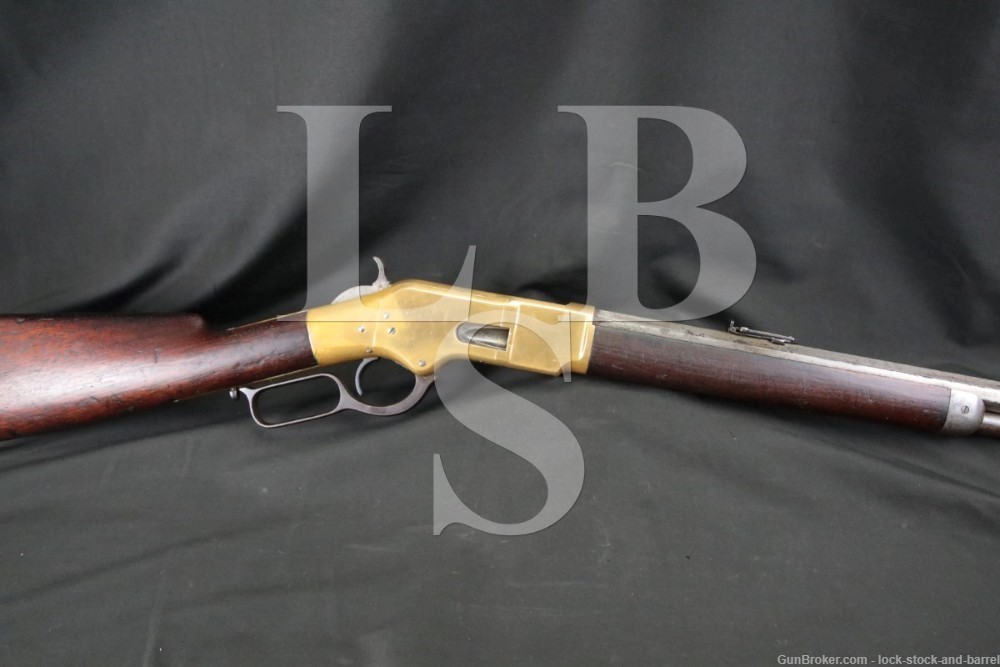
Winchester 1866 4th Model 24″ .44 Henry CF Lever Action Rifle, 1882 Antique
Sold for $4249.75
Make: Winchester Repeating Arms Co.
Model: 1866 Rifle 4th Model
Serial Number: 156277
Year of Manufacture: 1882
Caliber: .44 Henry. The bolt appears to have originally been equipped for both centerfire and rimfire, but now appears to only have the protrusion for centerfire.
Action Type: Lever Action with Tubular Magazine.
Markings: The top of the barrel is marked “WINCHESTER’S-REPEATING ARMS. NEW HAVEN. CT / KING’S-IMPROVEMENT-PATENTED-MARCH 29.1866. OCTOBER 16. 1860”. The lower tang is marked “156277”. The left of the bottom tang, the upper tang inlet and the inside of the buttplate at the toe are each marked with assembly number “2253”.
Barrel Length: 24” nominal, 24 1/4″ measured, Octagonal
Sights / Optics: The front sight is a german silver blade in a slotted base dovetailed to the barrel at the front. The rear sight is a folding ladder-style sight dovetailed to the rear of the barrel. The rear sight presents a fixed “U”-notch when folded down. When folded up, the ladder has a “U”-notched slider and is graduated from 0-20 in hundreds of yards.
Stock Configuration & Condition: The stocks are two-piece smooth walnut with an iron capped forend, straight comb, straight grip and iron crescent buttplate with a sliding door over a storage compartment (there is a four-piece cleaning rod in the compartment). There is a long crack at the left-front of the forend and a shorter crack at the left-rear. There are a couple of thin cracks at the rear of the top tang. The stocks have some scattered nicks, dings, scuffs and scratches. The LOP measures 13 3/8″ from the front of the trigger to the back of the buttplate. The plate has gone to a light-moderate patina with wear at the heel and some scattered light erosion. Overall, the stocks are in Good-Very Good condition as Antique.
Type of Finish: Blue & Brass
Finish Originality: The barrel and magazine tube appear to have been polished bright and there are some areas of the receiver which appear to have been polished, but there is no evidence of a new finish being applied.
Bore Condition: The bore is dark gray. The rifling is well defined. There is scattered light-moderate erosion and pitting in the bore.
Overall Condition: This rifle retains about 25% of its metal finish. The barrel and magazine tube have been polished bright with some areas going to a light patina and some scattered minor erosion. The receiver has gone to a mustard patina with areas showing the crystalline appearance of old brass and others appearing to have been polished in the past. There are scattered light nicks, scuffs and scratches with tool marks at and on the magazine bracket as well as at the rear sight dovetail. There are notable nicks at the edges of the hammer slot. There are tool marks around most screw heads. The action shows operational wear. The screw heads range from sharp to disfigured with usable slots. The markings range from clear to worn, but legible. Overall, this rifle rates in about Good condition as Antique (see Mechanics).
Mechanics: The rimfire striker bushing is missing the rimfire protrusions and the centerfire protrusion appears to protrude excessively from the bolt-face. Otherwise, the action functions correctly. The hammer does not have a half-cock safety. We have not fired this rifle. As with all used firearms, a thorough cleaning may be necessary to meet your maintenance standards.
Box, Paperwork & Accessories: This rifle comes with a four-piece cleaning rod stored in the buttstock.
Our Assessment: The Model 1866 rifle was the first firearm to be built by the new Winchester Arms after they changed their name from the New Haven Arms Company in 1866. The Model 1866 was a much-improved version of the Henry rifle, with a loading port on the right side of the receiver featuring a spring-loaded cover, through which cartridges could be fed into a new solid magazine tube that was much stronger than the slotted tube used on the Henry. The loading gate precluded the need for an external follower, allowing for a walnut forend to be installed which prevented the user from burning their hands during extensive firing. The M1866 was made in rifle, carbine and musket versions and in four different models dependent on date of manufacture. All of the different models were chambered in .44 Henry Rimfire, with some of the later 4th Models chambered in .44 Henry Centerfire and some converted to Centerfire later.
This is a Model 1866 4th Model Rifle made in 1882, after the successor Model 1873 had been introduced. The rifle has honest wear given its age, though the bolt’s centerfire protrusion appears to stick too far out of the bolt face. This Fourth Model is distinguished by the iron nosecap and buttplate as well as the slightly different profile of the receiver at the hammer. Most Winchester collectors would never think that their collection was complete without at least all three variations of the M1866, while some would argue for all of the variations of the four different models. This 1866 4th Model Rifle will be a neat addition to a collection and would be a good candidate for restoration. Please see our photos and good luck!
